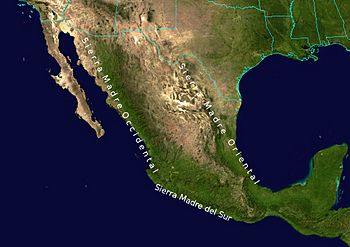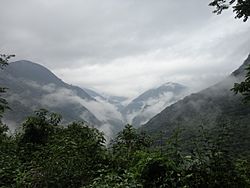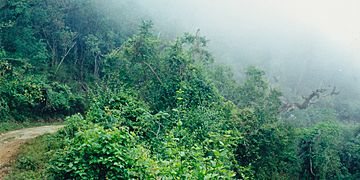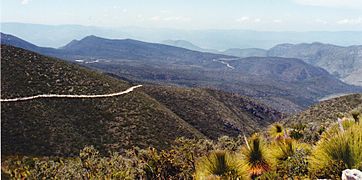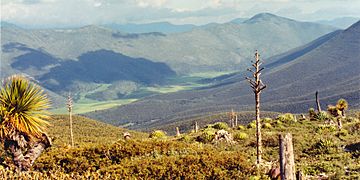Sierra Madre Oriental facts for kids
Quick facts for kids Sierra Madre Oriental |
|
|---|---|
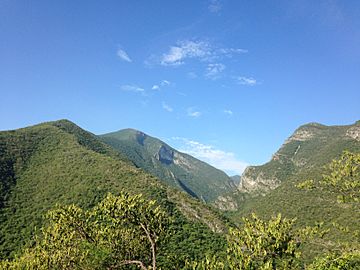
Sierra Madre Oriental near Ciudad Victoria, Tamaulipas
|
|
| Highest point | |
| Peak | Cerro San Rafael |
| Elevation | 3,700 m (12,100 ft) |
| Prominence | 1,855 m (6,086 ft) |
| Geography | |
| Country | Mexico |
The Sierra Madre Oriental is a large mountain range in northeastern Mexico. It is part of the American Cordillera, which is a long chain of mountains. This huge mountain chain forms the western "backbone" of North America, Central America, South America, and even Antarctica.
Contents
Exploring the Sierra Madre Oriental Mountains
This mountain range stretches for about 1,000 kilometers (620 miles). It starts near the Rio Grande river, which is the border between Coahuila and Texas. From there, it goes south through several Mexican states. These states include Nuevo León, Tamaulipas, San Luis Potosí, Querétaro, and Hidalgo. The range ends in northern Puebla, where it connects with another mountain range called the Eje Volcánico Transversal.
The northern parts of the Sierra Madre Oriental are the Sierra del Burro and the Sierra del Carmen. These mountains reach the border with the United States. North of the Rio Grande, the mountains continue into Texas. There, they are known as the Davis Mountains and Guadalupe Mountains.
To the east of these mountains is Mexico's Gulf Coastal Plain. This flat land lies between the mountains and the Gulf of Mexico. To the west, you will find the Mexican Plateau. This high flat area is about 1,100 meters (3,600 feet) above sea level. It sits between the Sierra Madre Oriental and the Sierra Madre Occidental, which is another mountain range further west.
Climate and Weather in the Mountains
The climate in the Sierra Madre Oriental is drier than the rainforest areas further south. The northern part, called the Serranias del Burro, is very dry. It is semi-arid to arid, meaning it gets little rain. However, in April and May, the mountains often cause strong thunderstorms. These storms can bring very large hail and even supercell tornadoes. These storms often form over or near the mountains. Then, they move east, sometimes traveling hundreds of kilometers into Texas.
Highest Peaks of the Sierra Madre Oriental
Cerro San Rafael is the highest point in the Sierra Madre Oriental. It stands at about 3,700 meters (12,139 feet) above sea level. It is also the highest point in the state of Coahuila.
| Rank | Mountain Peak | State | Elevation |
|---|---|---|---|
| 1 | Cerro San Rafael | 3700 m 12,139 feet |
|
| 2 | Sierra de la Marta | 3700 m 12,139 feet |
|
| 3 | Cerro el Potosí | 3700 m 12,139 feet |
Nature and Wildlife in the Sierra Madre Oriental
These tall mountains are known for their amazing variety of plants and animals. Many species found here live nowhere else in the world. This is true from the dry northern parts to the wetter southern areas.
Forests and Plants of the Mountains
The Sierra Madre Oriental pine-oak forests grow high up in the mountains. They are found between 1,000 and 3,500 meters (3,300 to 11,500 feet) above sea level. These forests have many types of pine trees, like Pinus nelsonii and P. cembroides. They also have different kinds of oak trees, such as Quercus castanea.
Lower down, on the eastern slopes, you find different plant areas. In Nuevo León and northern Tamaulipas, there is the Tamaulipan matorral. This area has woody shrubs, small trees, cacti, and succulents. Further south, the lower slopes have Veracruz moist forests. The eastern slopes at the very southern end have Veracruz montane forests.
West of the mountains, on the Mexican Plateau, there are deserts and xeric shrublands. These include the Chihuahuan Desert in the north. The central part of the plateau has the Meseta Central matorral. The southern plateau has the Central Mexican matorral.
Animals of the Sierra Madre Oriental
Many animals found here also live in the Sierra Madre Occidental. This other mountain range runs next to these mountains in western Mexico.
Birds that live in these forests include the Mexican chickadee and the Montezuma quail. You might also see the Strickland's woodpecker and the zone-tailed hawk. Several types of jay birds also make their home here.
The pine-oak forests in Coahuila are an important stop for monarch butterflies. These butterflies migrate through this area every year.
Protecting the Mountains and Their Wildlife
Over hundreds of years, much of the original habitat has been lost. This is mainly due to land being cleared for livestock grazing and logging.
However, there are protected areas to help save these natural spaces. These include the Cumbres de Monterrey National Park in Mexico. In Texas, the Big Bend National Park also helps protect the region. The El Cielo Biosphere in Tamaulipas is very special. It protects the northernmost tropical Veracruz moist forests in Mexico. It also has large areas of temperate cloud forests.
See also
 In Spanish: Sierra Madre Oriental para niños
In Spanish: Sierra Madre Oriental para niños
- Mountain peaks of Mexico
- Sierra Madre Occidental


